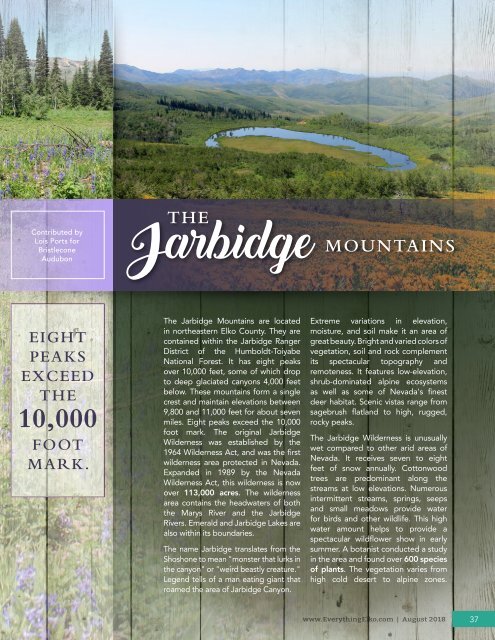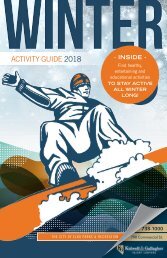eeaugust18
You also want an ePaper? Increase the reach of your titles
YUMPU automatically turns print PDFs into web optimized ePapers that Google loves.
Contributed by<br />
Lois Ports for<br />
Bristlecone<br />
Audubon<br />
THE<br />
Jarbidge<br />
MOUNTAINS<br />
EIGHT<br />
PEAKS<br />
EXCEED<br />
THE<br />
10,000<br />
FOOT<br />
MARK.<br />
The Jarbidge Mountains are located<br />
in northeastern Elko County. They are<br />
contained within the Jarbidge Ranger<br />
District of the Humboldt-Toiyabe<br />
National Forest. It has eight peaks<br />
over 10,000 feet, some of which drop<br />
to deep glaciated canyons 4,000 feet<br />
below. These mountains form a single<br />
crest and maintain elevations between<br />
9,800 and 11,000 feet for about seven<br />
miles. Eight peaks exceed the 10,000<br />
foot mark. The original Jarbidge<br />
Wilderness was established by the<br />
1964 Wilderness Act, and was the first<br />
wilderness area protected in Nevada.<br />
Expanded in 1989 by the Nevada<br />
Wilderness Act, this wilderness is now<br />
over 113,000 acres. The wilderness<br />
area contains the headwaters of both<br />
the Marys River and the Jarbidge<br />
Rivers. Emerald and Jarbidge Lakes are<br />
also within its boundaries.<br />
The name Jarbidge translates from the<br />
Shoshone to mean "monster that lurks in<br />
the canyon" or "weird beastly creature."<br />
Legend tells of a man eating giant that<br />
roamed the area of Jarbidge Canyon.<br />
Extreme variations in elevation,<br />
moisture, and soil make it an area of<br />
great beauty. Bright and varied colors of<br />
vegetation, soil and rock complement<br />
its spectacular topography and<br />
remoteness. It features low-elevation,<br />
shrub-dominated alpine ecosystems<br />
as well as some of Nevada's finest<br />
deer habitat. Scenic vistas range from<br />
sagebrush flatland to high, rugged,<br />
rocky peaks.<br />
The Jarbidge Wilderness is unusually<br />
wet compared to other arid areas of<br />
Nevada. It receives seven to eight<br />
feet of snow annually. Cottonwood<br />
trees are predominant along the<br />
streams at low elevations. Numerous<br />
intermittent streams, springs, seeps<br />
and small meadows provide water<br />
for birds and other wildlife. This high<br />
water amount helps to provide a<br />
spectacular wildflower show in early<br />
summer. A botanist conducted a study<br />
in the area and found over 600 species<br />
of plants. The vegetation varies from<br />
high cold desert to alpine zones.<br />
www.EverythingElko.com | August 2018<br />
37
















